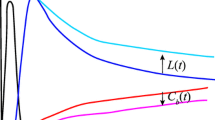Abstract
Methods of parametric imaging of radionuclide angiography using parameters like appearance time, peak time, transit time, height of peak, arterial slope and area of inflow were developed and evaluated regarding their diagnostic meaning in 111 patients suffering from TIA or PRIND and in 30 normal persons. The meaning of these single parameters could shown depended on the specificity of the diagnostic question. Local cerebral blood flow can be estimated most favourably by parametric images of area of inflow whereas transit time is most promising as a diagnostic tool for evaluation of total cerebral blood flow classified with reference to severity of the perfusion disturbance. Appearance time is suited very well to estimation of collateral perfusion. Blood flow in great cerebral arteries could be seen well by non parametric imaging of radioactivity inflow in the brain supplying arterial vessels in the cranial floor. Applying a combination of the parametric images, the sensitivity for detection of disturbances of cerebral blood flow amounts to 0.91. A specificity of 0.88 and accuracy of 0.90 were found. The described combination of evaluation of RNA using various parameters is considered a well suited method for detection of disturbances in local and total cerebral blood flow by means of planar imaging.
Similar content being viewed by others
References
Arnim WH von, Schicha H, Beker V (1976) Isotopenuntersuchungen der Hirndurchblutung mit der Fucks-Knipping-Kamera. Nuklearmedizin 15:22–25
Celsis P, Mere-Vergnes JP (1985) Measurement of cerebral circulation time in man. Eur J Nucl Med 10:426–431
De Roo M, Devos P, Goffin J (1982) Comparative study of the sensitivity of CT and quantitiative angioscitigraphy in cerebrovascular disease. Eur J Nucl Med 7:345–352
Fieschi C, Agnoli A, Battistini N (1966) Relationship between cerebral transit time of non-diffusible indicators and cerebral blood flow. A comparative study with 85-krypton and radioalbumin. Experientia 22:198–190
Hlises R, Frenzel S (1985) Automatische Auswertung von Hirnsequenzszintigraphien mittels Funktionsbidern nach GAMMA-Fit. In: Fortschritt der automatischen Bildauswertung und Chromosomenanalyse. Tagungsbericht Nr. 234 der Akademie der Landwirtschaftswissenschaften, Berlin, p 149
Hühnerhoff B (1983) Nichtinvasive Untersuchungen der Hirnperfusion mit 99 mTc 04-, Dissertation Göttingen
Kuriyama Y, Aoyama T, Tada K (1974) Interrelationships among regional cerebral blood flow, mean transit time, vascular volume and cerebral vascular resistance. Stroke 5:719–724
Lindner P, Wolf F, Schad P (1980) Assessment of regional cerebral blood flow by intravenous injection of 99 m Technetium-pertechnetate. Eur J Nucl Med 5:229–235
Lindner P (1983) Quantitative, non-invasive cerebral blood flow measurement with non-diffusible tracers using a heart rate dependent recirculation correction — application in carotid surgery. Eur J Nucl Med 8:358–363
Lindner P, Nickel O, Schad N (1984) Nearly simultaneous measurement of quantitative cerebral blood flow, cardiac index and ejection fraction with the short lived isotope 195 mAu. Eur J Nucl Med 9:A 235 (abstr.)
Oldendorf WH (1962) Measurement of the mean transit time of cerebral circulation by external detection of an intravenous injected radioisotope. J Nucl Med 3:382–398
Smith AL, Neufeld GR, Ominsky AJ (1971) Effect of arterial pCO2 tension on cerebral blood flow, mean transit time and vascular volume. J Appl Phys 31:701–707
Szabo Z, Ritzl F (1983) Mean transit time image — a new method of analyzing brain perfusion studies. Eur J Nucl Med 8:201–205
Vosberg N, Szabo Z, Nase D (1984) Optimierung der quantitativen Hirnperfusionsszintigraphie durch Parameterbilder der mittleren Transitzeiten. In: Höfer R (ed) Radioaktive Isotope in Klinik und Forschung. Egermann, Wien, pp 43–52
Author information
Authors and Affiliations
Rights and permissions
About this article
Cite this article
Lerch, H., Franke, W.G. & Hlises, R. Parametric imaging in cerebral radionuclide angiography (RNA) by planar imaging improving presentation and objectivation of cerebral blood flow. Eur J Nucl Med 15, 96–99 (1989). https://doi.org/10.1007/BF00702627
Received:
Accepted:
Issue Date:
DOI: https://doi.org/10.1007/BF00702627




